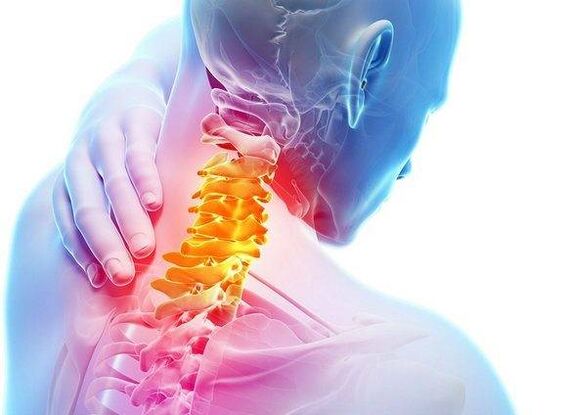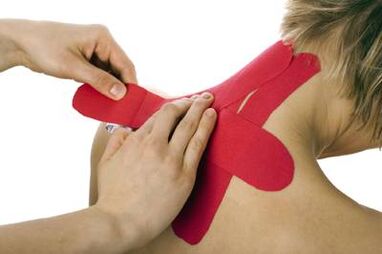A lifestyle for office workers and those who want to rest in front of the TV or behind the monitor screen often cause osteochondrosis. In the article we will consider what is osteochondrosis of the cervical spine, the main causes of this disease, its symptoms and stages, methods of treatment, and answers other questions that occur in patients with osteochondrosis.

The osteochled process affects any of the spine or some immediately. The lumbar and cervical vertebrae are more affected by pathologies, as the most sensitive to loads due to the anatomy of the human skeleton. The consequences of spinal osteochondrosis in the cervical region cause more annoyance and possible complications because the neck is a rich area of neuromusive highways, many of which feed the brain directly. In addition, the nerve roots, which provide the sensitivity and motor activity of the hands and shoulder band, when squeezing with destroyed vertebrates can give a variety of symptomatic photography.
Signs of neck osteochondrosis depend on which of the body systems are affected by the pathology:
Below, consider the overall osteochondrosis clinic of the cervical spine. Pain in the back of the area of the head, neck and collar. This is the most common symptom. Localization of the pain can be enlarged, affecting the shoulders, the clavicle region, the chest, turning into intense head migraines. The nature of the pain depends on the localization of the lesion and the severity of the pathology. At first, the pain can be quickly transient, becoming gradually chronic, painful. In times of irritation, the pain becomes the shooting, with an increased tone of the neck muscles and limited head movement. Often, pain with cervical osteochondrosis can be located after the sternum, in this case many patients take this symptom for angina pectoris.
Noise, ringing, sensation of blockages in the ears
These symptoms often join a hearing a decrease. These phenomena are associated with a decrease in blood flow from the vertebral arteries to the vestibular apparatus. The complex of these symptoms is called cochlear, or snail syndrome, and it is not always possible to determine its association with osteochondrosis in the cervical region. One specific feature for differentiation is that noise, blockage and ears are felt when changing position, after a long stay in one position.
Dizziness
Dizziness is also due to a violation of blood flow to the inner ear organs, which ensures body balance. Nystagm often joins dizziness - arbitrary fluctuations in the students' eye on the sides.
Noise
This sensation appears due to the irritation of the edges of the diaphragmatic nerve. It is an ingredient of the cervical nerve beam and is involved in the regulation of breathing, depth and frequency. Patients complain about the inability to breathe in the full chest. In some cases, the symptoms exacerbated in severe shortness of breath and drowning. For the same reason, breathing stops at night and snoring. The disadvantage of oxygen due to respiratory problems is ultimately the cause of increased fatigue, a decrease in concentration and memory problems.
Nausea
It is accompanied by air that waist. Also due to problems with blood circulation in some areas of the brain and inner ear. Nausea is sometimes observed with unbearable vomiting provoked by head and body movements. The consequence of nausea and frequent vomiting is a decrease in appetite, weight loss, nutritious failure.
Problems with vision

"Flies" in the eye, a decrease in visual acuity, fog before the eyes - these are all symptoms due to the ischemia of the brain area that is responsible for vision. Patients with osteochondrosis complain less frequently, as the lack of blood supply from the vertebral vessels is offset by the blood flow from the carbon artery system. Glasses and therapeutic gymnastics for the eye muscles do not solve the problem, usually vision improves after treatment of osteochondrosis.
Green symptoms
It can often be the only sign indicating osteochondrosis of the cervix. They are expressed as a sweating, dryness and feeling of a lump in the throat, difficulty swallowing. Symptoms are associated with compression of the nerve plexus responsible for the intrigue of the pharynx. It is necessary to distinguish such manifestations from a similar clinic for inflammation or neoplasms.
How to treat cervical osteochondrosis
The prescribed condition of the spine is a very serious pathology, which, with negligence, leads to disability, and as a result of deep disorders of cerebral circulation and death. For this reason, with self -medication, if such symptoms appear, you should not do. Osteochondrosis is treated in a hospital and at home, exclusively as prescribed by a doctor. In the early stages, the treatment of cervical osteochondrosis is conservative, which includes drug recipes: non -steroidal anti -inflammatory drugs, anesthetics, hormone drugs, vitamin complexes, chondroprotectors -all of these restore inflammation, pain, improves the trochphot of soft tissues.
In the acute period, the drug is prescribed in the form of injections, as the pain descends, the patient goes into tablets. Physiotherapy, massage, exercise exercises usually defined at the remission phase, join the drug courses. In difficult cases, osteochondrosis is treated with surgery.
Cervical back diagram
The cervical spine osteochondrosis (osteohondrosis) is a degenerative-degenerative lesion of the intervertebral discs, which damage the wheels, vertebrae and joints of the cervical region, a decrease in the height of the intervertebral discs is observed. The disease progresses if left untreated, and can lead to headaches, circulatory disorders and even hernia. Like osteoporosis, the disease occurs due to violation of mineral metabolism, as a result of which bones and joints become less stable. Osteochondrosis can cause cervical spine instability (symptoms and treatment are similar to chondrosis but have a number of features), which is often associated with a shift of vertebrae. On the other hand, this accelerates the development of osteochondrosis, destroying the vertebrate.
The main causes that can cause osteochondrosis:

Most of the above reasons cause a load on the cervical vertebrae, as a result of which muscle spasms occur. Because of this, the circulatory process is disturbed, the effectiveness of metabolic processes decreases, which causes degenerative changes. The structure of the intervertebral discs changes, they dilute and deform, speaking beyond the spine. Often the cause of osteochondrosis is a progressive disk, spread to adjacent vertebrae or bone tissue. Most often it happens with a prolonged physical exercise in the lumbar and cervix, almost never touching the chest. Development, osteochondrosis goes through several stages characterized by certain signs and symptoms. We will consider these stages below.
Osteochondrosis of the 1st degree of cervical region (pre -clinical phase)
Usually, in the initial stage of development of the disease, only the slight alleviation of the neck lordosis is observed, patients undergo pain that intensifies with curves and sloping of the head, feel the tension and rapid fatigue of the muscles in the back and lower spine. At this stage, osteochondrosis is cured without medication, it is enough to change food, perform exercises and other events.
Osteochondrosis 2 degrees
In the second stage between the vertebrae, instability is observed, the patient begins to disturb a stronger pain, which periodically gives him in his hands or shoulders, the pain also intensifies with curves and slope of the head. Patients begin to notice rapid fatigue, lack of lack, decrease in performance levels and headaches.
Osteochondrosis 3 degrees
At this stage, the pain begins to intensify, it occurs constantly not only in the neck but also on the shoulders, gives it in his hands. Hand muscles become weaker, numbness is observed, as the hernia of the intervertebral discs begins to form. In this case, the diagnosis reveals the small movement of the cervical region. Patients are concerned about dizziness and weakness.
Osteochondrosis 4 degrees
In the last stage, the intervertebral discs are destroyed, which are replaced with connective tissue. The pathological process affects some ridge segments immediately, which may be at different stages of destruction. In patients, there is a violation of coordination, dizziness and pain have improved, there is noise in the ear and other disorders. Even the initial stage of the disease can be identified according to the following signs:

One of the most common signs is dizziness for cervical back osteochondrosis. At the same time, the symptoms of dizziness can be associated with noise and ringing in the ear (reduced hearing sharpness), disorienting sensations, migraines, as well as nausea and vomiting. Moreover, it is a doctor who determines how to treat these symptoms that you should not try to get rid of dizziness by popular methods. Another unpleasant consequence is frequent pain, especially in women. Migraine can occur several times a day, causing unpleasant and painful sensations. Signs of cervical region disease manifest in a slightly different way than the other back osteochondrosis in the connection that the vertebrae in the neck is close to each other, the height of the intervertebral discs is small, which leads to complications even with minor degenerative changes.
Symptoms of cervical osteochondrosis that occur in the brain
With the development of osteochondrosis, the blood flow to the brain trunk through the arteries, which are compressed by prolonged ends of the vertebrae, decreases. As a result, there is a violation of brain blood circulation. In patients, neurotic disorders are observed: irritability, anxiety, frequent mood change, dissatisfaction, insomnia, the ability to focus is reduced. In some cases, outbursts of anger, fear, desire can occur. Vascular spasms can lead to pallor, headaches, ear noise, appearance of points in front of the eyes. In this case, the following symptoms of irritation appear: dizziness, feeling of instability, nausea, in some cases vomiting.
Treatment of cervical back osteochondrosis
For the treatment of a disease such as osteochondrosis, different methods are used: medicines, physiotherapy, cervical-brothers massage for the blood supply of the brain and therapeutic gymnastics, and maintaining proper nutrition. Despite the fact that women are more susceptible to headaches and limb numbness in this disease, the treatment of cervical osteochondrosis in women is no different from their treatment in men: the same medicines and exercises are prescribed.
Diagnostic methods
An experienced doctor easily diagnoses cervical osteochondrosis, as the disease has a characteristic clinical appearance. To determine the stage, neglect and predominance of the pathological process, a number of additional examinations are described to the patient:
Usually, only cervical back radiography is sufficient, the most expensive methods are used in confusing and unclear cases.

Physical education
Exercises for cervical osteochondrosis are allowed to do strictly during remission, movements in the acute phase can lead to a deterioration in the patient's condition. All physiotherapy exercises are reduced to curves and tendencies of the head. It is important to perform actions slowly, without unexpected movements. In case of pain - stop learning and seek advice for a specialist.
If a person has a tendency to develop pathology, he should visit a specialist periodically and undergo research. This will help to identify the disease at an early stage and start treatment on time. For example, cervical osteochondrosis, the symptoms of which are described in the article, affect the cervical vertebrae and begins to literally destroy them. What will come from it is easy to imagine.


















